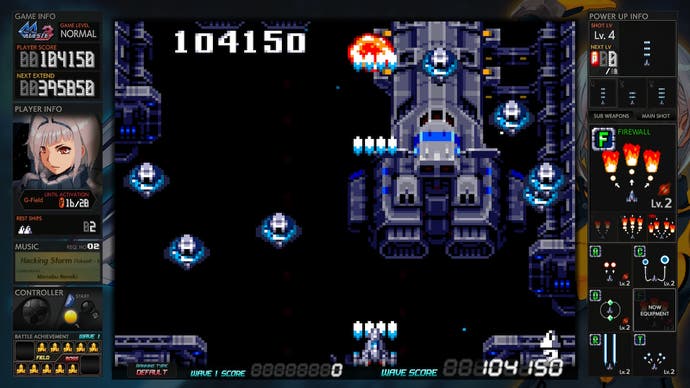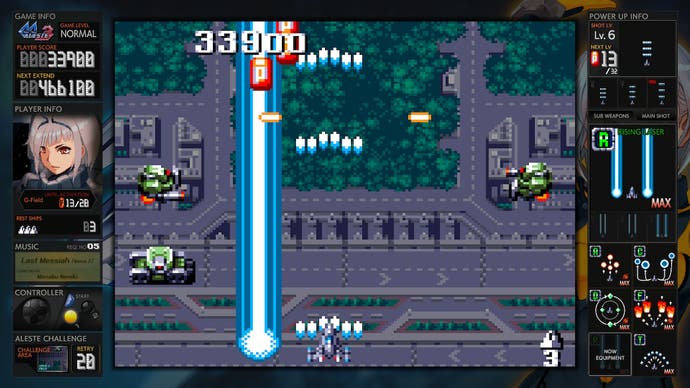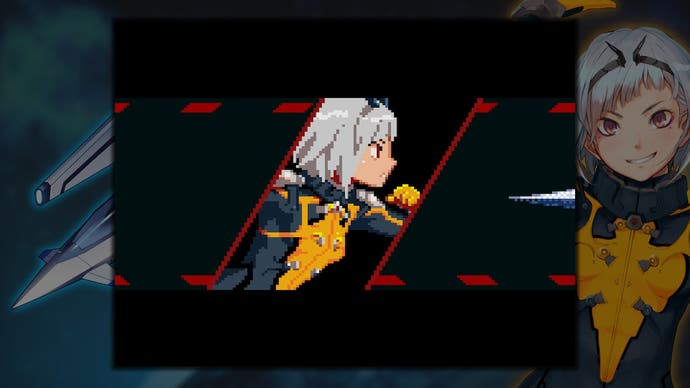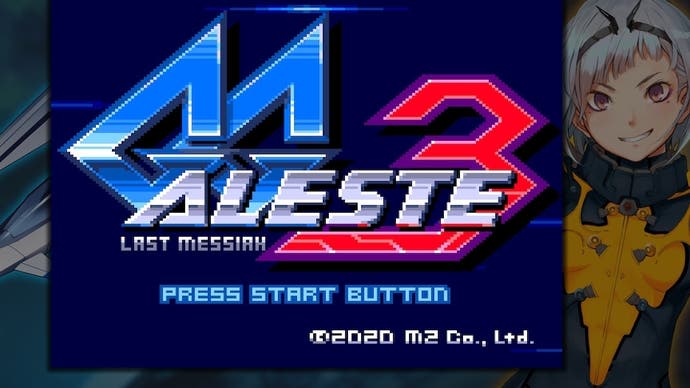How M2 went back to the Game Gear for its magnum opus
Aleste'd development.
Modern games based on the perceived technical limitations of vintage systems are not uncommon. However, it takes a certain kind of courage - maybe even a tiny little bit of madness - to not only emulate the look and feel of yesteryear's classics, but to produce games for systems long past their prime. While such endeavours do happen in the indie- and homebrew-sector, it's unheard of for bigger companies to dabble in this sort of development. Nintendo, Square Enix or SNK might happily re-release their back catalogues in various physical or digital formats, it's unlikely they would ever go back to their old devkits.
Enter M2, a fascinating publisher and developer located in Tennodai near Tokyo, mostly known for producing conversions of classic games to modern hardware. M2 always goes the extra mile in order to deliver a product that not only immaculately represents the original games, but also improves them in many regards - always optionally of course. M2 is the kind of company to take the plunge into the technical depths of vintage hardware, as it has shown in the past: For one of its earlier Sega Ages projects, Fantasy Zone for PlayStation 2, the team programmed a port of the Master-System-exclusive Fantasy Zone 2 for Segas System 16 arcade-board; for the Namcot Collection in summer 2020, they helped produce impressive NES-conversions of Gaplus and Pac-Man Championship Editions.
These projects now feel like a dress rehearsal for M2's magnum opus: GG Aleste 3, an all-new entry into the venerable Aleste-series for the Sega Game Gear. Yes. That Game Gear. The dim-screened, battery-guzzling handheld that fruitlessly took on Nintendo's Game Boy in the early 90s but surprised with a neat library of games. GG Aleste 3 is part of the Aleste Collection that came out in Japan last December for Switch and PS4 and is not yet slated for a western release. The collection consists of fantastic ports of Aleste on Master System, released as Power Strike in the west, its PAL-exclusive sequel Power Strike 2 and the two Game Gear episodes GG Aleste and GG Aleste 2, the latter of which was also renamed to Power Strike 2 in the west, just to make things extra-complicated.

While the original games have aged graciously and are fun by themselves, it's the new GG Aleste 3 that's quickly captured players' attention. And rightly so, as GG Aleste 3 is a marvel - both technically and mechanically. Instead of including a little bonus-game, a small, experienced team created a full-blown sequel. Seven stages filled with countless enemies, giant bosses, beautiful pixel-graphics and a wonderfully balanced difficulty-curve make GG Aleste 3 one of the best shooting games in recent memory. With the Game Gear's 160x144 resolution, GG Aleste 3's look brings to mind modern indie-games on platforms like Pico-8, but it also sports a degree of polish like the best offerings of the 90s.
It's a magnificent trip down memory lane for the old school-shooter-crowd. Early levels feel like classic Aleste while later stages venture into Raizing territory with veritable bullet-barrages on screen. Players can be thankful for the frequent bouts of slowdown (which can be deactivated in the options), giving them a very breather amidst the intensity. Without any hyperbole; GG Aleste 3 alone is worth the price of the Aleste Collection, but in a package with four other, often very expensive 8-bit shooting-games, the Aleste Collection feels like a steal. But just as interesting as the game itself is its creation.
Manabu Namiki, a veteran game composer with great shooting games such as Battle Garegga and Deathsmiles on his resume, served as director, game designer and composer for GG Aleste 3. He recalls the early stages of the project: "Initially, Mr. Horii, M2's CEO, contacted me and said he wanted me to be the sound creator for GG Aleste 3. But when I tried to get more details from him, I found out that it wasn't even decided on who would direct the project or do the planning, let alone what the game would be like. In short, the entire thing was a blank slate."

He quickly became intrigued by the prospect of working on a real new game for Game Gear: "At that time, I was working on another project as its sound director. This project, however, had some problems in the planning / directing layer, and it wasn't clear where it was headed. It was in a long stalemate, and I was kept in a limbo without accomplishing any of the things I was appointed to that project for. That had left me quite frustrated. I thought it would be a pity if such a wonderfully insane idea as making an all-new Game Gear shooting game should go down the same road, all because of a lack of proper planning/directing. That is why I stepped forward and volunteered to be its director."
The daunting programming-task meanwhile was handed to Takashi Yamashita, who goes under the moniker FAW Labo - a true veteran of the 8-bit days, who served as programmer of legendary shooting games like Super Star Soldier and Star Parodier and hasn't lost his knack for vintage hardware at all, as he explains: "I actively develop games for classic hardware as my personal projects, and upload video clips of them on my YouTube channel. I do Mark 3/Master System too, so it was everyday stuff for me." That however, was not the case for the rest of the team: "This time around we worked as a team after all, so I also made tools and laid out specifications to make it easier for the other members to understand."
In contrast to modern game development, 8-bit games are created with much less comfortable tools, but current technology still proved to be a great boon, as Takashi Yamashita discusses: "Regarding the process, we went with cross development using assembly and an emulator with debugging features. We wrote the code and tested it on the emulator, and every time it reached some set goal we tested it on the actual hardware using flash cartridges. The biggest difference is that now we have emulators, without questions. They are even equipped with rich debugging features, so we don't have to rely so much on ICE either. It also involves less steps to run your code on emulators. That being said, even running code on the actual hardware is made far simpler these days, by virtue of flash cartridges. Also the PCs we develop the code with have far better specs than those in the 90's. They assemble code so fast that I can't take a break while building binaries any longer!"

Modern technology made the development faster and more comfortable, but nothing GG Aleste 3 does would have been impossible some 30 years ago: "All the techniques I used for this development were already in wide use back in the 90s, so I don't think I did anything that deserves to be called a trick. It's more like I used every known technique to present the game in a modern way", Takashi Yamashita explains. Still, the game profits from modern trends and knowledge of the shooting-genre, as Manabu Namiki points out: "In designing GG Aleste 3, I wanted to follow in the footsteps of GG Aleste and GG Aleste II and pay due respect to the heritage of past Compile shooters. On the other hand, I took this occasion to look back at the long path which shoot-'em-ups had taken since the 90's up until modern days, and tried to reflect in GG Aleste 3 the evolution the genre had made in that course, as much as I found suitable."
To make things clear right now; there is no actual new Game Gear cartridge available and there probably never will be - the game is exclusive to the Aleste Collection and a very limited white Game Gear Micro console sold with the Collection's Special Edition. But nevertheless, the game would run on proper hardware. The obvious limitations of the old hardware sometimes became painfully obvious, but the team took these in a stride. Takashi Yamashita recalls: "The place where I wish I had more processing power is every scene that the game frame-skips in general. This happens more often compared to GG Aleste or GG Aleste 2, and that made me painfully aware that I still have much to learn."

Manabu Namiki adds: "Some of the ideas I had at the time of laying out the initial plan proved unfeasible due to hardware limitations and had to be discarded. For example, there's a nuclear missile in the background of WAVE 5. I wanted enemies to get behind that missile and hidden from view, but I had to give up on that because of limitations on the display priority. That said, you can't make a good game by moaning over every idea that turns out unfeasible and blaming the hardware for that. We just stood firm and began by implementing what seemed achievable. At the same time, we were always seeking to contrive ways (we call that "tonchi" in Japan) to make real the things that seemed almost impossible at first glance."
There is one more instance, where GG Aleste 3 follows in its predecessors footsteps: After Ellinor and Alice Wizn, a female pilot called Lluna Wizn boards the cockpit this time. So is there any relationship between these characters and games? Manabu Namiki wants to leave that to the players themselves: "As for her relationship with either Ellinor or Alice, I'd like to leave that to your speculation. We prefer to have you enjoy using imagination to fill out blanks, and don't want to give too many answers that may be restrictive."

Still, he offers a peek behind Lluna's creation: "Both of the pilots in the previous GG Alestes were female and surnamed Wizn, so it was decided early on that we would do the same. However, the actual name was undecided at that stage and we simply called her Wizn or Miss Wizn. We commissioned Kisai Takayama to do her character design, and from the time we got the first drafts I secretly began building up a stock of possible names. After that, I worked on the game's backstory and wrote the prologue and the epilogue, in between developing the game itself. Eventually I had a clearer picture and the result was Lluna as we now know her."
One thing I had to ask Mr. Namiki to shed more light on was Llunas fondness of pudding, one of these typical little tidbits of information often given about the heroes of Japanese action-games. Turns out, this is a bit of an in-joke by Manabu Namiki: "I might mention that Takumi Yamashita, who programmed GG Aleste 2, was fanatical about Glico's Pucchin Pudding (a famous Japanese supermarket brand of dessert) at the time." Apart from all the glorious 8-bit action on screen, it's those little things like that show the love and dedication Manabu Namiki, Takashi Yamashita and the rest of the team put into this grand little shooting game.
Many thanks to Ken Senda for his help in making this article happen


